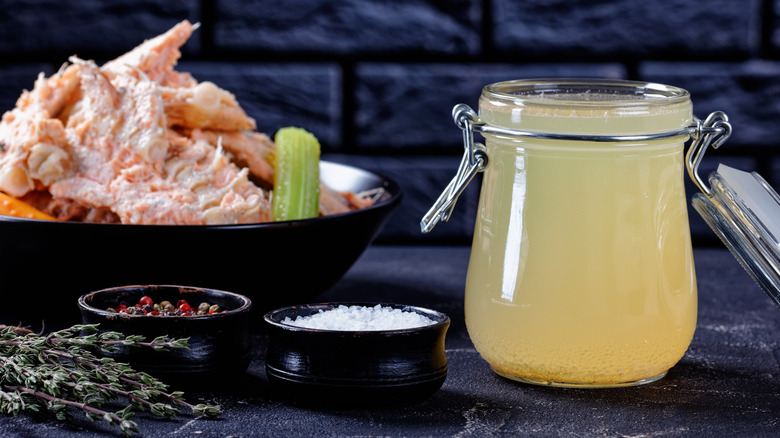The Cleaning Tip You Should Know For Better Tasting Fish Stock
Mastering the art of crafting a flavorful fish stock is a fine skill to have in the kitchen. It's a great way to repurpose odds and ends, and the resulting stock can elevate any pescatarian recipe whether it's used as the base ingredient in a classic French bouillabaisse or worked into a decadent seafood risotto. Offering a delicate flavor (but still bolder than a mellow vegetable stock), a fish-based broth boasts nuances of salt and the sea. However, if your recipe lacks a fresh oceanic quality, it's worth rethinking how you clean your fish scraps.
When it comes to building a stock, there's no limit as to what can be tossed into the pot. Along with a host of aromatics, any number of fish scraps can be used to season the liquid. That said, to avoid an overly oily or pungent broth, it's best to stick to the various bits and bones of white fish or the shells of sweet crustaceans like prawns and lobsters. But, even then, you might end up with a less-than-lip-smacking outcome. The culprit? Bloody bones.
Fish bones add depth and texture to stock. Yet, when they're incorporated without being completely cleaned (or at least, close to it), they tend to impart a bitter flavor due to bloody residue. As a result, this can transform an otherwise mild and fresh stock into one with an intensely fishy fragrance and unpleasantly metallic flavor. Residual blood can even darken and cloud the broth, greatly reducing its visual appeal.
The ultimate way to clean fish scraps
Before adding anything to a stockpot, pause. First, consider whether or not a certain scrap will benefit flavor. For example, mussel or clam shells won't do much except take up space in the pot. Next, think about which scraps have the potential to ruin flavor — acrid-tasting gills are rarely a good idea. Beyond flavor, it's also wise to think about practicality. For example, nixing pin bones in favor of bigger bones makes the broth easier to strain later.
With scraps selected, you can kick off the cleaning process. For the sweetest fish stock, wiping slimy or bloody residue off carcasses with a paper towel just won't do. Instead, we suggest rinsing bones under cold running water, before letting them soak. To extract blood and debris even faster, you can also salt the water. After an hour or two, drain the water and rinse the scraps under cold running water once more. Finally, the cleaned scraps can be tossed into a stockpot.
Although it might seem like this extensive cleaning process will rid scraps entirely of their flavor, this isn't the case. Cleaning only eliminates unsavory impurities, resulting in a vibrant stock that isn't plagued by extreme fishiness. Of course, if you do want to subtly increase depth, you could always roast clean bones prior to adding them into stock. Regardless, clean scraps are sure to provide enough drool-worthy flavors.

